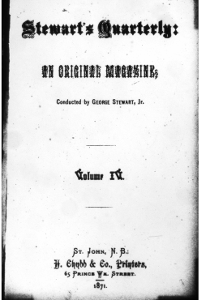Stewart's Literary Quarterly

After George Stewart, Jr. terminated The Stamp Collector’s Monthly Gazette (1865–67) at the age of sixteen, he founded Stewart’s Literary Quarterly Magazine (Saint John, 1867–72). It was, said George Parker, the “first national magazine of Confederation” ("Literary Journalism" 92). Stewart was the editor and publisher throughout the quarterly’s life, and he also contributed his own material to the paper. These contributions included reviews of works or other magazines (many of them American), opinion pieces, and short fiction. Stewart founded the quarterly on the belief that good literature could “elevate and refine” emotions and morals, and though most of the content was literary or cultural, there were also non-literary contributions on politics, news, geography, and the environment (Parker 1096). As such, the magazine was unique, original, and eclectic – a “testament both to [Stewart’s] faith in Canada and to the central role he played in shaping the country’s cultural identity” (Fullerton).
Stewart founded his literary quarterly as much to stimulate literary development in Canada as to provide an alternative to what he considered the low-brow American magazines that were starting to circulate in this country. Always a proponent of a diverse Canada, he went out of his way to feature French-Canadian literature and reviews, praising, for example, Quebec writer François-Xavier Garneau’s Histoire du Canada depuis sa découverte jusqu'à nos jours as a “work of rare ability” (qtd. in Fullerton). Throughout its run, the quarterly was noted for its writing and, in some cases, controversial content. Among the more controversial articles were “Human Progress – Is it Real?” by Rev. Moses Harvey and “Women’s Rights and a Woman’s View of Them” by “Diana.” In the first example, Rev. Harvey sought to argue that geology proves evolution is real and therefore part of the Divine plan, and, in the second, a writer simply called Diana outlines the hardships and suffering of women and women’s responses to those hardships. Diana’s article countered another article by Hannibal Hatblock called “Women’s Rights” that mocked women’s rights as the cause of female insubordination and justification for divorce. “My wife is small in stature, wavy brown hair, hazel eyes, and used to have a sweet expression – but she hasn’t now. Reason she hasn’t – ‘women’s rights!’” Hatblock said (qtd. in Stewart, 1867 30).
These controversies ensured that the magazine was both popular in New Brunswick and received modest national attention. As importantly, the controversies showcased a Maritime perspective at a time when American content was spilling over the border. Calling that content “cheap yankee literature,” Stewart endeavoured to use his magazine to save “the youth of New Brunswick from cheap American fiction” (qtd. in Gerson 50).
In addition to opposing American trade populism, Stewart's literary quarterly focussed on disputes between Britain and France over colonial sovereignty, Canadian Confederation, and opinions associated with a liberalizing democracy. Those opinions included discussions about natural resources, popular music, history, medical science, technology, tobacco use, and, incredibly, mustache culture. Always dominant, however, were book notices, puzzles, reviews, and other literary miscellany.
Toward that end, the quarterly became known for its belles-lettres style. One writer who employed this style was Alexander Rae Garvie. In polemics such as “About Plagiarism” and “A Reverie,” Garvie challenged New Brunswickers to think beyond the conventional. In “About Plagiarism” he wrote: “Yet if the poor wretch who steals meat or money, often from extreme necessity, is so strictly dealt with, why is a literary thief so often set free, or rather not apprehended?” (qtd. in Stewart, 1869 253). The point was to encourage Maritimers to write about their own place in their own voice.
Another author who developed a following in Stewart's magazine was New Brunswick’s James Hannay. He became renowned for his ballads, two of which appeared in the quarterly. The first was “Aubrey: A Ballad of Acadie” and the second “LaTour: A Ballad of Acadie.” “LaTour” was loved because of its rich local detail:
Down from the fall’s great rapid the river rushes free;
It doubles round a point of land and turns towards the sea.
A bow-shot off, an island divides the racing tides,
Whose current for a thousand years has frayed its rocky sides. (qtd. in Stewart, 1869 113)
Spanning five volumes, Stewart’s Literary Quarterly had a loyal readership. After succumbing to financial problems in 1872, it became The Maritime Monthly in 1873, the new magazine providing an outlet for Stewart’s previous writers and supporters. That magazine ended in 1875. Later in 1892, Stewart praised his Saint John publisher, George James Chubb, for supporting local publishing, lauding the fact that Chubb, “from the first issue to the last,” never made a profit from publishing Stewart’s Literary Quarterly (qtd. in Parker 93).
Shawn Goff, Fall 2014
St. Thomas University
Bibliography of Primary Sources
Stewart, George, ed. Stewart’s Literary Quarterly 1.1 (1867): 1, 30.
---, ed. Stewart’s Literary Quarterly 2.3 (1869): 113.
---, ed. Stewart's Literary Quarterly 3.3 (1869): 253.
Bibliography of Secondary Sources
Bissell, Claude. “Literary Taste in Central Canada During the Late Nineteenth Century.” Canadian Historical Review 31.3 (1950): 237-51.
Bowness, Suzanne. “In Their Own Words: Prefaces and Other Sites of Editorial Interaction in Nineteenth-Century Canadian Magazines.” Diss. U of Ottawa, 2012.
Cogswell, Fred. “Literary Activity in the Maritime Provinces, 1815–1880.” Literary History of Canada. 2nd ed. Ed. Carl F. Klinck. Toronto: U of Toronto P, 1965. 116-137.
Daniells, Roy. “Confederation to the First World War.” Literary History of Canada. 2nd ed. Ed. Carl F. Klinck. Toronto: U of Toronto P, 1965. 205-221.
Fullerton, Carol. “Stewart, George.” Dictionary of Canadian Biography. Vol. 13 (1901–1910). Toronto: U of Toronto P, 1994. Dictionary of Canadian Biography Online. 2003. U of Toronto/U Laval. 23 June 2020
<http://www.biographi.ca/en/bio/stewart_george_13E.html>.
Gerson, Carole F. “Shaping the English-Canadian Novel, 1820–1900.” Diss. U of British Columbia, 1997.
Parker, George. “Literary Journalism Before Confederation.” Canadian Literature 68 (Spring/Summer 1976): 88-100.
---. “Stewart, George, Jr.” The Oxford Companion to Canadian Literature. 2nd ed. Ed. Eugene Benson and William Toye. Toronto: Oxford UP, 1997. 1096-1097.


